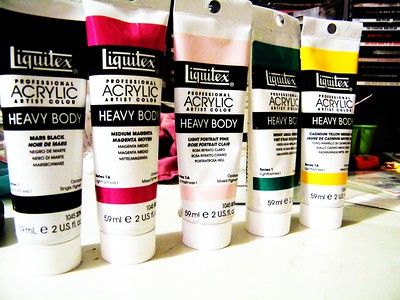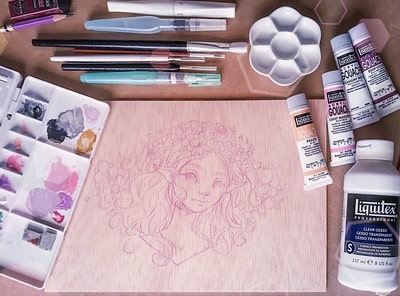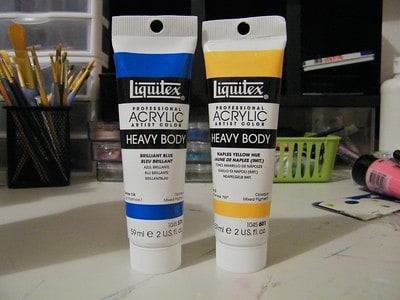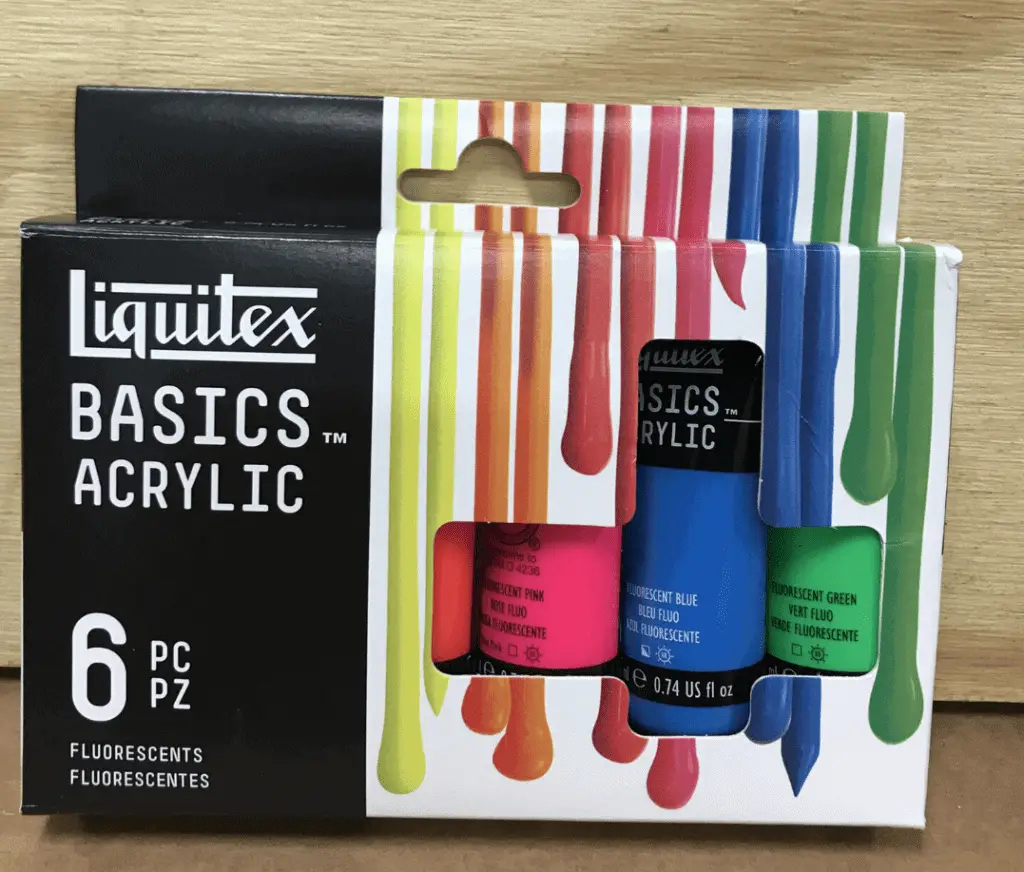Liquitex acrylic paints come with plenty of uses! Every artist can benefit from having some of them in their art kit. There are many different shades of paints to choose from, and you receive a high-quality product. However, many people want to know if the paint is safe for frequent use.
So, is Liquitex acrylic paint non-toxic? All Liquitex acrylic paints have the AP seal from ACMI (Art and Creative Materials Institute, Inc.) and are safe for anyone to paint with. These paints contain non-toxic ingredients and are a lot of fun to use!
If you have young children at home, you won’t have to worry about the paint harming them. It’s completely non-toxic and perfect for kids to paint with too! Overall, there’s a lot that you’ll want to know about Liquitex acrylic paints. Let’s keep reading!
Liquitex Acrylic Paint

Liquitex is a very well-known brand among artists today. The company produced the original water-based acrylic paints, which came out in 1955. As the artist’s first water-based acrylic, their paint formula is very reliable, vibrant, and long-lasting.

You can use these paints for many different purposes in your art. Liquitex says that their paint is perfect for even underpainting and sketching- so you’re sure to find a use for it! Overall, this brand has a lot to offer artists. Their painting materials are also non-toxic, which is a huge plus for many people.
Is All Acrylic Paint Non-Toxic?

Most acrylic paints are non-toxic, although you’ll need to be careful. Some pigments do contain ingredients that can be harmful to people. For example, some acrylic paints can contain cobalt, manganese, lead, chromium, or cadmium.
These paint ingredients are toxic! However, they aren’t dangerous in the paint tube. They only threaten your health if you sand down the paint and breathe it in, put them into an airbrush, or accidentally eat large amounts of the paint.
In general, acrylic paints are only harmful when they enter the body. That means you need to either ingest them or breathe them in large amounts. If you get it on your skin, you shouldn’t have to worry right away. Take some time to wash your hands- acrylic paint is water-based, so it comes off very easily with a bit of warm soap and water.


Since acrylic paints are water-based, they’re very safe for general use. You’ll need to be sure to wash your hands after painting and take care not to breathe the paint in. However, whether or not paint is toxic will depend on the brand that made it! Similar pigments can vary in their formulas among brands, even if the shade of paint is the same color.
Overall, most acrylic paints are non-toxic. However, there are still some pigments that contain toxic ingredients to create a specific color. You’ll want to check that your paints have a seal that indicates they’re non-toxic, especially if you plan on giving these paints to children to use.
My favorite and top pick is always Arteza Acrylic Paints. They have so many different colors, and the quality is amazing! I usually use Arteza Paints for all my projects.

Is Liquitex Acrylic Gouache Non-Toxic?

The entire Liquitex range of painting products includes the ACMI non-toxic “Approved Product” seal. That means these paints contain no harmful amounts of toxins. They won’t be toxic to people or cause other health issues later on.
Liquitex’s acrylic gouache is also non-toxic! You can safely achieve intense pigments in your work with a pleasing matte finish. The color is also durable, permanent, and even water-resistant!

You can get all these benefits while using their acrylic gouache without worrying about the paint being toxic. Liquitex makes sure not to include harmful ingredients in their pigment composition.
Lastly, Liquitex’s acrylic gouache is also safe for older kids! You still may not want to let young children use it if they’re likely to try putting the paint in their mouths.
Is Liquitex Acrylic Paint Safe for Skin?

Liquitex acrylic paint is safe on your skin for short amounts of time. However, this isn’t body paint! You won’t want to use it as one. Instead, choose face and body paints as these materials are better suited for human skin.
You’d want to wash your hands and arms after painting if you got some on your skin. Of course, painting can be messy- so don’t panic if you get some on yourself. You’ll be fine as long as you take a moment to wash it off when you finish working on your painting.

According to the U.S. Consumer Product Safety Commission (or CPSC), your skin can absorb chemicals from paint, so you’ll want to wash it off. While there aren’t any toxic chemicals in paints that come from this brand, it’s still a good idea to remove the paint. Letting it sit for too long could cause minor irritation.
In short, while Liquitex acrylic paint isn’t necessarily bad for your skin, you won’t want to use it as face or body paint. It would be best to remove all the paint after using them to prevent them from bothering your skin. That said, you won’t need to worry that much about it.
Is Liquitex Acrylic Paint Water Based?

Liquitex acrylic paints are water-based. Their formula uses a unique recipe, making it very different from other acrylic paints. These paints have a full body and resemble oil paints. Although, they don’t contain any oils!
It is easy to confuse Liquitex with oil-based paints because they appear very similar. However, Liquitex paints are, in fact, water-based. The current formula that the brand uses comes from 1963, offering tried and tested reliability.
Overall, you can trust that these paints are water-based. Even if they look and behave like oil paints, their make-up only includes water-based ingredients. There are no oils in these pigments.
Is Liquitex a Good Brand?

Liquitex is a great brand! The company is very well-known among students since they usually need to buy large amounts of paint on a very strict budget. You’ll find plenty of options at a great price from this brand.
Plus, Liquitex makes all of its paints using high-quality ingredients. That means you receive beautiful, vibrant pigments that offer an easy-to-work-with consistency. You can blend colors and apply them in thick layers to add more texture to your canvas.
Many artists love this brand- it’s been around since 1955. During this time, Liquitex has perfected its paint formula! You can trust them to stand behind all of their products. Many artists recommend them to one another.
Not only does Liquitex sell acrylic and gouache paint, but they also make paint primers and sealers. This is great if you like to stick to the same brand for all your painting materials.
The acrylic professional primer, and their gloss varnish are two products that I use always every time I paint!

In short, I’d have to say that Liquitex is an excellent brand. They produce plenty of materials that are at artist quality levels. Plus, the brand offers paints that come in different finishes. For example, you can find glossy acrylic or matte formulas, giving you more variety.
Final Thoughts
To summarize, Liquitex acrylic paints are non-toxic. While some pigments usually use toxic materials in other brands’ paints, Liquitex doesn’t include them in their formulas. Your favorite paints won’t contain any harmful ingredients when you buy them from this brand.
Having non-toxic options is very important in the painting world! You can use these paints with kids safely and will have more peace of mind overall while you create. In short, these paints are very high-quality and come with plenty of benefits that you’ll want to consider.
Make sure to follow all my tips and recommended products to ensure your acrylic painted project turns out great! Also, don’t forget to check out my other articles for all your painting Q&A’s. Happy painting!

